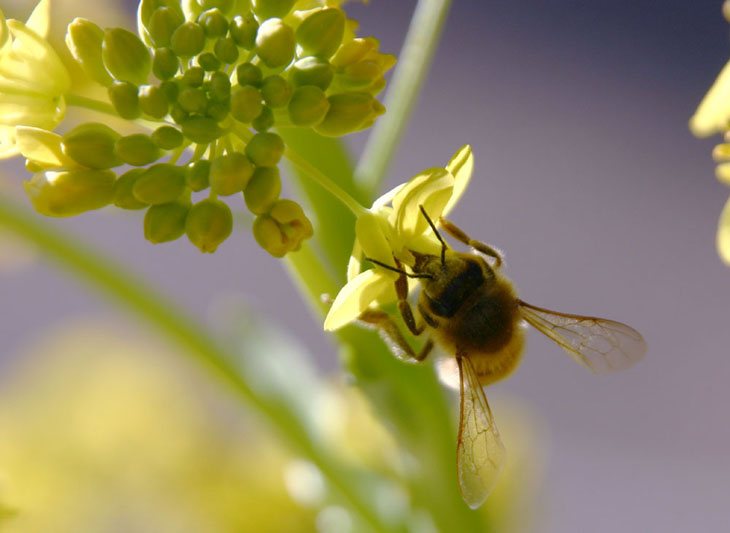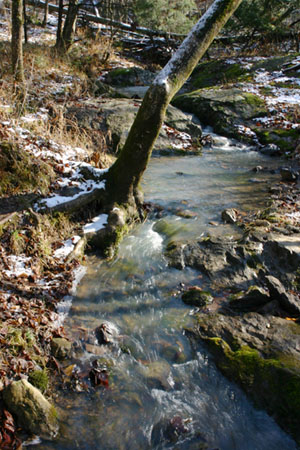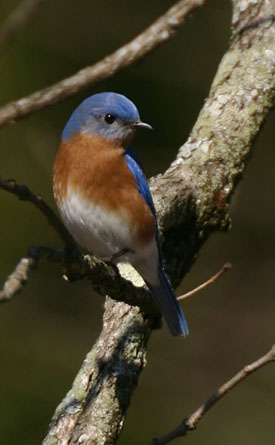
When going back through my files of images, I can get a rough idea of what time of year photos were taken by the apparent seasons displayed within. Sometimes.
Friday, after meeting with a student I went down to the North Carolina Botanical Garden to drop off some paperwork, and took the opportunity to check the potential of staging a few photos that I needed for seminars. It was a gorgeous day, so while we had just come off a severe cold snap a few days earlier, I was walking around without a jacket and sporting a faint sunburn from meeting outdoors. However, some of the ponds in the garden had an apparent texture to their surfaces from the thin veneer of ice still present. At the same time, I was seeing clusters of frog eggs and some massive tadpoles, and did some grab shots of bees on flowers that were blooming. Most people see the arrival of spring in a positive light, yet I may personally feel this even stronger; I start coming out of my winter funk because I know I’ll be having lots of subjects to chase after the dry period. The following Saturday was, if anything, even better.
Then came Sunday, when the wind picked up, the skies went dark, and rain turned to sleet and then snow, this first snow we’ve had this winter here in central NC. In fact, I think we somehow went through 2011 without any snowfall at all here; even though we don’t get much, it’s rare that we get none. This one served as a reminder that spring is not here yet.
 Then Monday dawned clear and bright, promising to melt off the little snow that we’d received. In The Amityville Horror, visitors supposedly heard a voice saying, “Get out!” and while that book was a total crock of shit, I get much the same internal reaction when we have sunlight on snow. After doing a few shots around the yard, I scampered off down to the river to see what could be found there.
Then Monday dawned clear and bright, promising to melt off the little snow that we’d received. In The Amityville Horror, visitors supposedly heard a voice saying, “Get out!” and while that book was a total crock of shit, I get much the same internal reaction when we have sunlight on snow. After doing a few shots around the yard, I scampered off down to the river to see what could be found there.
These are the kind of conditions that fool the exposure metering functions within cameras. Sunny days already produce high contrast, and the presence of snow makes it even harder, even when it’s patchy. Cameras are calibrated for average scenes which usually feature a mix of middle tones, so when the tones are either very dark or very bright, the camera is often fooled. Wet ground with little foliage tends to be dark, while snow is bright, so depending on what is being read through the viewfinder, the camera’s recommended exposure can go way off base. Unless you like working with ambient light meters and fixing your settings manually, it’s much better to bracket exposures by adjusting camera settings to over- and under-expose several frames of the same subject to try and capture the one that works best. If you look closely at this image, you’ll notice that very little of the snow becomes fully white, and in fact, the shadows are actually quite dark. Letting the snow become too bright takes away the detail and looks harsh, and might even hide the textures that indicate snow in the first place. One of the prime advantages of digital is taking several versions of the same image with different settings just to ensure one keeper, but this should be done judiciously, with at least some idea of how the exposure is being measured and what is necessary to compensate. At the same time, one of the disadvantages of digital is reviewing the results with the LCD on the back, since these are rarely very accurate and can be exceptionally misleading about how the resulting image really looks. Never, ever trust the LCD.
 Even in winter at minimal tree foliage, the number of pines we have here reduces the amount of snow reaching the ground in wooded areas, so the river featured even less snow than the yard, and that was disappearing fast. I’ve had issues with camera batteries fading fast in cold weather, but the greater risk was from moisture, as snowmelt produced a light rain throughout the forest, constantly threatening the camera every time I selected a subject and paused. The reflections from snow and water drops also contributed to the difficult shooting conditions, since such specular highlights exceed the exposure latitude by a wide margin, creating flare, ghosts, and color-fringing. Then there’s the winter sun, sitting low in the sky throughout North America and thus casting long shadows, or getting into the lens if one faces the wrong way. Shadows are sneaky little things until you’re used to watching them, since they appear much less distinct to our eyes than they do in photos, and we readily ignore the darkness cast across our subject until we look at the images later and realize the dark patches aren’t contributing to the positive effect.
Even in winter at minimal tree foliage, the number of pines we have here reduces the amount of snow reaching the ground in wooded areas, so the river featured even less snow than the yard, and that was disappearing fast. I’ve had issues with camera batteries fading fast in cold weather, but the greater risk was from moisture, as snowmelt produced a light rain throughout the forest, constantly threatening the camera every time I selected a subject and paused. The reflections from snow and water drops also contributed to the difficult shooting conditions, since such specular highlights exceed the exposure latitude by a wide margin, creating flare, ghosts, and color-fringing. Then there’s the winter sun, sitting low in the sky throughout North America and thus casting long shadows, or getting into the lens if one faces the wrong way. Shadows are sneaky little things until you’re used to watching them, since they appear much less distinct to our eyes than they do in photos, and we readily ignore the darkness cast across our subject until we look at the images later and realize the dark patches aren’t contributing to the positive effect.
What still images don’t convey is the sounds of the day. The snow melting from the branches produced a steady patter of drops, heightened somewhat by the crackle of them hitting snow on the ground. More interesting was the enthusiastic calls of the frogs from just up this stream a short ways, where they seemed quite pleased with the weather conditions and proclaimed that appearances can be deceiving – spring really is kicking in. Back home, the cries of the red-shouldered hawks have been making the same thing clear for the past week or so, since this is mating and nesting season. None of them were giving me a decent view for any images yet, but that’s only a matter of time.
 The conditions were also pleasing to the songbirds, who were raiding the yard for seeds and showing off to potential mates. Last fall during the migration period we had a cluster of Eastern Bluebirds (Sialia sialis) checking out the new bluebird box we’d put up much earlier, which had gone unoccupied last year, so we’re hoping they elect to use it this season. While I’d rather have a setting that looks much more natural, just their presence will provide lots of opportunities for behavior shots, and perhaps I can catch the young during fledging and flight practice.
The conditions were also pleasing to the songbirds, who were raiding the yard for seeds and showing off to potential mates. Last fall during the migration period we had a cluster of Eastern Bluebirds (Sialia sialis) checking out the new bluebird box we’d put up much earlier, which had gone unoccupied last year, so we’re hoping they elect to use it this season. While I’d rather have a setting that looks much more natural, just their presence will provide lots of opportunities for behavior shots, and perhaps I can catch the young during fledging and flight practice.
I’ll use this to point out a small, yet very effective, trick for better animal images – the catchlight. You can see a pinpoint reflection of sunlight in the bluebird’s eye here, and this adds a tremendous amount to the vibrancy of the animal in the photo. Since animals prefer not to have the sun in their eyes, they don’t sit in positions to produce this effect very often, so it usually takes patience, readiness, and a quick shutter to capture it – but it also takes knowing that this improves the image so that you actually seek it. The benefit is that you’re also ensuring the sun is coming from a better angle (showing off the great colors of their plumage or fur, as the case may be) and remaining aware of shadows. I tracked this one back and forth a few times, down to the ground and back up again, before he finally posed to bring it all together.
So yeah, if I was trying to judge the season by weather and animals, I’d be seriously confused right now, but as a photographer I’m led around by the subject matter. Whatever works.




















































